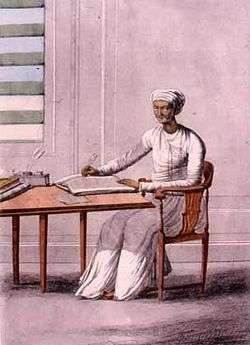Karan (caste)
Karana is a caste found predominantly in Odisha, Telangana and Andhra Pradesh. They are generally a regional subcaste of Kayastha and used to perform the functions, predominantly, of a scribe in Medieval times. They represent around 5% of Odia people[1]
| Karana | |||
|---|---|---|---|
| |||
| Classification | Kayastha | ||
| Religions | Hinduism | ||
| Languages | Odia | ||
| Populated States | Odisha | ||
Origin
According to many historians, Karana caste was a mixture of both Brahmin and Dhobi caste. In classical Odisha ar. 600 AD, each community aspired to a Varna in fourfold varna system, hence the major communities of Odisha were the Brahmins and Kshatriyas who lead the populace. It so happened that a man from the Dhobi (washermen) community happened to be married with a Brahmin women which caused a great controversy for their children. The children's father belonged to a shudra varna community, however the children wanted to be coronated as Brahmins.[1] However, debate arose began when the child would not be considered as authentic Brahmin by the Brahmin community of Odisha due to rigidity of the ancient varna system. Also the Kshatriyas would not accept the child as their attitudes were similar to that of the Brahmins, considering the child to be of lower caste. However, the Gajapati Maharaja of that time intervened in this matter and hence a new community was created, called Karanam (trans. to do/work) which traditional occupation was that of a scribe in the royal court. Hence, this caste were not given a specific varna, but did perform the rights of an administrator, writers, Goumastha/Munshi (trans. collecter) and were in general, considered the upper echelons of Odia society. [2] [3]
Present Day
Despite such a minuscule number, in regards to overall Odia population, Karana caste is the most prominent and one of the most advanced communities in Odisha. Their literacy level is the highest among all communities in Odisha, and their representative power is highest when compared to their population strength. After the end of feudalism in India and Odisha, the powerful Khandayats lost lot of their political power due to seizure of land by the government. Hence, the Brahmins came in forefront in regards to political power and education due to the respect they had in society, especially during the mid 20th century. However, since then, as Karana were one of the most educated communities (surpassing that of the Brahmin and Khandayat communities), they emerged as a single most powerful representative bloc in terms of politics and media. Post independence, the communities has produced many illuminaries in both politics and Film industry, and has a great impact on present Odia culture. [4]
Customs
Karana caste generally follow the patriarchal system in regards to civic duties and follow customs and marriage rituals which are similar to both major communities, Brahmin and Khandayat. They are also known to follow a patrilineal gotra system similar to other two communities, however their gotras are totetismic in origin, unlike the other two. Also, marriage along the clan (sa-gotra) is generally forbidden. [2][3]
Titles
Titles and surname include Maity, Mohanty, Pattnaik, Kar and Das.
References
- 1 2 Williams, Joanna Gottfried (2010). "The Two-headed Deer: Illustrations of the Rāmāyaṇa in Orissa". Google Books. Retrieved 14 October 2016.
- 1 2 Thurston, Edgar; Rangachari, Kandur (2001). "Castes and Tribes of Southern India". Google Books. Retrieved 15 October 2016.
- 1 2 Pruthi, RK (2004). "Indian Caste System". Google Books. Retrieved 15 October 2016.
- ↑ Grover, Verinder (1999). "Political System in India: Politics of influence, violence and pressure groups". Deep & Deep. Retrieved 13 October 2016.
